You've got multiple effective options for cooking without electricity in your off-grid kitchen. Solar ovens harness the sun's power during peak hours (11 am – 3 pm), while Dutch ovens offer versatile cooking using charcoal or wood. For long-term cooking, thermal methods keep food hot for hours after initial heating. Wood-burning techniques require seasoned wood under 20% moisture for ideal heat, and proper fire building skills guarantee consistent temperatures. Don't forget essential safety protocols like maintaining clear spaces and keeping water nearby. These fundamental techniques open the door to mastering your off-grid culinary journey.
The Power of Solar Ovens
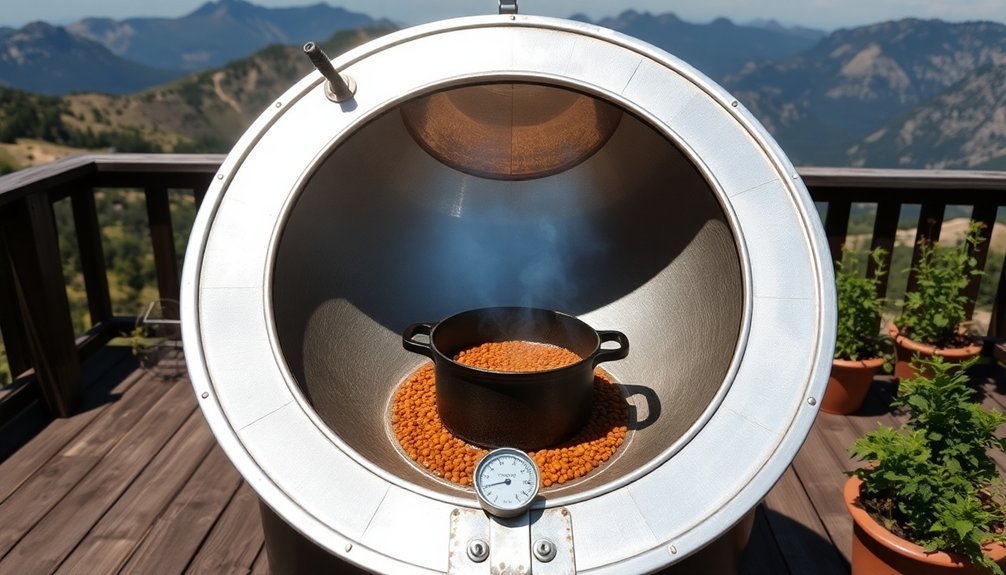
How can a simple box transform sunlight into a powerful cooking tool? By combining reflective surfaces, insulation, and strategic design, you'll harness the sun's energy to create temperatures up to 350°F – perfect for cooking meals without electricity or fuel.
Your solar oven needs aluminum foil to reflect sunlight, black surfaces to absorb heat, and clear plastic wrap or Plexiglas to trap it inside.
Add newspapers and cardboard for insulation, and you've got a sustainable cooking solution. For best results, use your solar oven between 11 am and 3 pm, keeping it directly aligned with the sun. Never look directly at the sun while positioning your solar oven.
Remember to rotate the oven and stir food periodically for even cooking. You can bake cookies, roast vegetables, or even make small pizzas while contributing to a greener planet.
Dutch Oven Cooking Fundamentals
Three essential components make Dutch oven cooking a cornerstone of off-grid meal preparation: proper equipment selection, heat management, and cooking technique mastery.
You'll need a quality cast-iron Dutch oven, typically 12 inches for versatility, along with heat-safe accessories like lid lifters and long-handled tongs. The superior heat retention of cast iron makes it ideal for consistent temperature control in outdoor cooking environments.
- Heat distribution: Use twice as many briquettes as the Dutch oven's diameter, placing more on top for baking.
- Temperature control: Create even heat by spreading coals in a ring pattern on both lid and bottom.
- Cooking methods: Excel at baking, braising, stewing, and searing with proper preheating.
- Performance tips: Oil surfaces before cooking, use flavorful liquids instead of water, and let the pot cool before cleaning.
Master these fundamentals, and you'll transform your off-grid cooking capabilities.
Mastering Thermal Cooking Methods
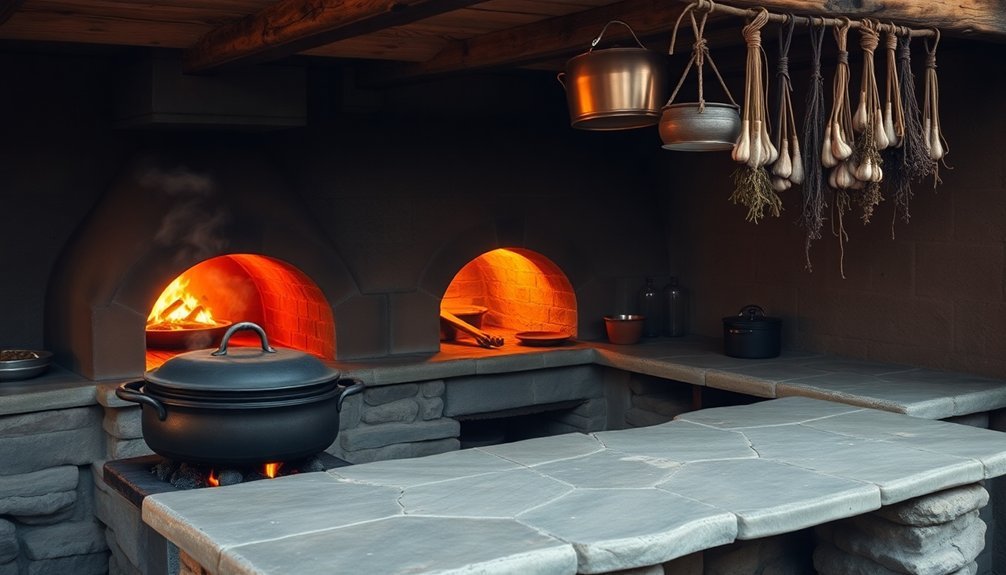
While Dutch ovens rely on constant heat, thermal cooking harnesses trapped heat to continue cooking your food long after the initial heat source is removed.
You'll find this method particularly effective for soups, stews, and saucy dishes that benefit from slow cooking.
To master thermal cooking, start by bringing your food to a boil during midday. Once boiling, transfer it to your thermal cooker, where it'll maintain temperature for hours without additional fuel.
You can prepare dinner early while avoiding a hot kitchen later in the day. Installing proper carbon monoxide detectors ensures safe indoor cooking operations.
This versatile method integrates well with other off-grid cooking approaches.
You'll save energy by using initial heat from a propane stove or solar oven, then letting the thermal cooker do the rest.
It's portable, efficient, and perfect for maintaining hot meals wherever you are.
Safe Propane Stove Operations
Operating a propane stove safely requires careful attention to setup and maintenance procedures. Before lighting your stove, you'll need to check the tank connections, turn on the solenoid, and verify proper pressure readings. Always make sure you're cooking in a well-ventilated area to prevent carbon monoxide buildup. The bright red warning light indicates when the solenoid system is actively allowing propane flow to your stove.
- Begin by inspecting hoses for damage and making sure tight connections before turning on the propane tank.
- Test for leaks using a soap-water solution when changing tanks or if you suspect problems.
- Don't force controls if they're not working properly – contact a service technician instead.
- When shutting down, turn off the solenoid first to allow remaining gas to burn off, then close the tank valve.
If you ever smell gas, don't attempt to light the stove – contact your propane supplier immediately for assistance.
Efficient Wood Burning Techniques
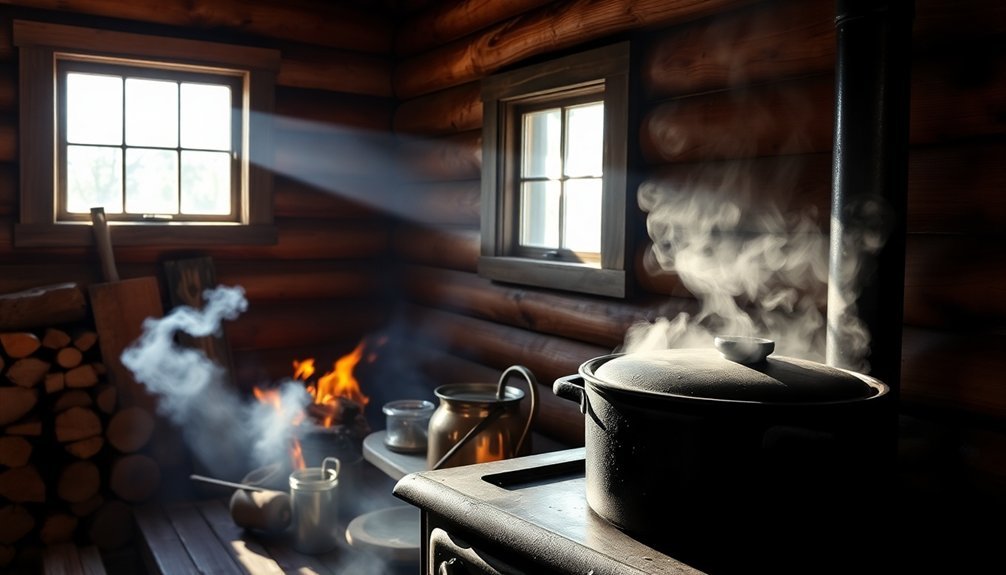
When burning wood for cooking, you'll get superior heat output by using properly seasoned wood with less than 20% moisture content, rather than green wood which wastes energy evaporating excess water.
You'll achieve ideal fire safety by maintaining a clean chimney, keeping combustibles away from the stove, and monitoring temperatures with a stove pipe thermometer.
To minimize smoke, guarantee complete combustion by maintaining high temperatures above 600°C, using preheated air intake, and avoiding overfilling your stove's firebox.
Seasoned Vs Green Wood
The choice between seasoned and green wood can make or break your off-grid cooking experience. You'll want seasoned wood with its 15-20% moisture content, as it burns hotter and more efficiently than green wood.
When you're cooking off-grid, seasoned wood's higher heat output and cleaner burn will help you maintain consistent temperatures and avoid smoky flavors in your food.
- Look for light-colored wood that makes a hollow sound when struck together – this indicates proper seasoning.
- Store your seasoned wood elevated off the ground and covered from rain.
- Split wood into appropriate sizes for your cooking setup before storing.
- Guarantee proper airflow when burning to maximize heat output.
Don't waste time with green wood – it'll frustrate your cooking efforts with excess smoke, poor heat, and constant tending to maintain the fire.
Fire Safety Best Practices
Safe and efficient wood burning requires three fundamental practices that every off-grid cook must master: regular maintenance, proper fire management, and rigorous safety protocols.
| Safety Measure | Why It Matters |
|---|---|
| Annual Inspection | Prevents creosote buildup and identifies damage early |
| Carbon Monoxide Detectors | Warns of dangerous CO levels before they're lethal |
| Proper Ash Disposal | Prevents unexpected fires from hot embers |
You'll need to have your chimney cleaned yearly by a certified sweep to remove creosote deposits and check for damage. When building fires, start them from the top to achieve high temperatures quickly, and never let them smolder. Keep your wood stove's doors closed except when loading fuel, and always extinguish fires before heading to bed. Store your firewood outdoors under cover, and keep a fire extinguisher within easy reach.
Smoke Control Methods
Building upon proper fire safety habits, mastering smoke control techniques will greatly improve your off-grid cooking experience. You'll achieve cleaner combustion by using dry firewood with less than 18% moisture content and maintaining proper airflow through your stove.
Keep the secondary air valve fully open during initial lighting, and leave the door slightly ajar for 5-10 minutes to establish strong combustion.
- Light your fire from the top to reach high temperatures quickly and reduce smoke output
- Maintain a 2-3 cm layer of insulating ash at the bottom for ideal combustion
- Adjust air supply valves based on weather conditions and funnel draught
- Use only clean, untreated wood to prevent toxic smoke emissions
Remember to monitor smoke levels and make adjustments to your air supply as needed throughout the cooking process.
Campfire Cooking Essentials
To cook effectively over an open flame, you'll need to start by mastering proper fire-building techniques, including the strategic placement of tinder, kindling, and larger wood pieces.
Your essential toolkit should include a Dutch oven, cast iron skillets, grill grates, and heat-resistant utensils that can withstand direct flame exposure.
You'll also need to follow key safety protocols, such as maintaining proper distance from the fire, keeping water nearby, and using protective equipment like heat-resistant gloves when handling hot cookware.
Fire Building Best Practices
Mastering four essential fire structures forms the foundation of successful off-grid cooking. Your choice of fire layout directly impacts your cooking success, heat control, and fuel efficiency. Each structure serves specific purposes, from quick meals to long-lasting cooking sessions.
- Build a tepee fire for quick starts and initial heating, using tinder at the base and gradually adding larger sticks.
- Create a log cabin structure when you need sustained heat for longer cooking times.
- Stack logs tightly for a platform fire when you're planning to use pots and pans.
- Set up a lean-to fire for simple cooking with skewers or sticks.
Remember to maintain your ember bed by pushing coals to the center and adding new fuel at the edges.
For ideal cooking results, let the flames die down and cook over the hot coals.
Equipment and Tool Selection
A well-equipped outdoor kitchen begins with selecting the right tools and vessels for campfire cooking.
You'll need a Dutch oven and cast iron skillet as your primary cooking vessels, as they distribute heat evenly and work perfectly for slow-cooking meals. Don't forget essential utensils like metal tongs, a long-handled spatula, and heat-resistant gloves to protect your hands.
For versatility, include specialized gear such as a pie iron for toasted sandwiches, skewers for grilling, and roasting forks for marshmallows and hot dogs.
A grill grate with collapsible legs will elevate your pans above the flame. Complete your setup with an outdoor kitchen set that includes basic utensils, a sharp knife, cutting board, and containers for spices and condiments.
Keep a water container nearby for cooking and safety.
Safety Around Open Flames
Once you've gathered your outdoor cooking equipment, prioritizing safety around open flames becomes your next essential step.
You'll need to manage your fire carefully, ensuring it's both legal and appropriately sized for cooking. Build your fire on one side of the pit and move hot coals to your cooking area for better control.
Remember to protect yourself by wearing closed-toe shoes and using long-handled tools.
- Clear the area of flammable materials and stack extra wood upwind to create a natural windbreak
- Keep flames manageable – glowing embers work better for cooking than large flames
- Don't cook directly over fire; use hot coals to prevent burnt food and dangerous flare-ups
- Always keep water nearby and never leave your fire unattended, especially with children present
Preserving Food Without Electricity
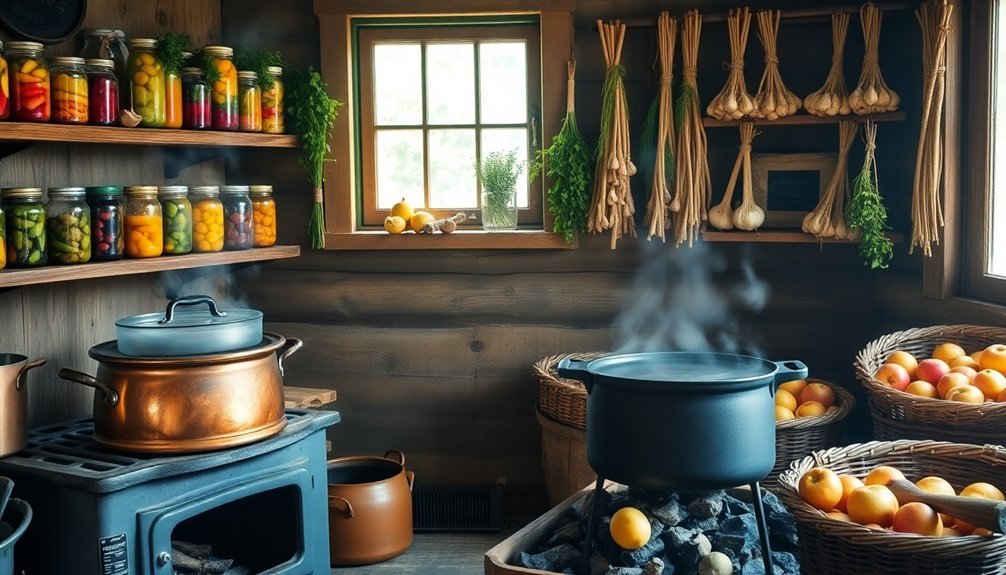
Living without electricity doesn't mean you have to compromise on food preservation. You can master several time-tested methods to keep your food fresh and nutritious for extended periods.
Dehydration offers a simple solution – use the sun, wind, or a fire-heated still house to remove moisture from fruits, vegetables, and meat.
Through fermentation, you'll create nutrient-rich foods while promoting gut health, particularly effective for vegetables and dairy products.
When preserving meat and fish, try curing with salt or smoking, which not only extends shelf life but also adds delicious flavors.
Don't forget about pickling and oil preservation. You can submerge foods in vinegar or oil to prevent spoilage while enhancing their taste.
These traditional methods have sustained communities for generations and remain practical for modern off-grid living.
Emergency Heat Sources
When power outages strike, having reliable emergency heat sources becomes a matter of survival.
You'll find several safe and effective options for maintaining warmth in your off-grid kitchen. Traditional fuel-based solutions like kerosene and propane heaters offer reliable heat when properly ventilated, while DIY methods can provide quick solutions during unexpected emergencies.
- Set up a propane buddy heater or catalytic heater for immediate, clean-burning warmth.
- Create simple terracotta pot heaters using canned heat and non-flammable materials.
- Install a pellet stove for long-term, efficient heating using recycled wood materials.
- Keep portable soapstone warmers ready for localized heat when needed.
Remember to maintain proper ventilation with any fuel-based heating method and regularly check your chosen heat source for safe operation.
Always store adequate fuel supplies for your preferred heating options.
Frequently Asked Questions
How Long Does a Solar Oven Work Effectively on Cloudy Days?
You'll find that solar ovens work effectively for 2+ days on cloudy days if they're well-insulated, though you'll need longer cooking times and temperatures will drop to 225-300°F for slower-cooking foods.
Can Different Types of Charcoal Affect Dutch Oven Cooking Temperatures?
Yes, your charcoal choice matters greatly. Briquettes give you more reliable temperatures than lump charcoal or campfire coals. You'll get steadier heat and better control using high-quality briquettes in your Dutch oven cooking.
What's the Shelf Life of Unused Propane and Butane Fuel?
You'll find that propane has an indefinite shelf life when properly stored, while butane typically lasts 7-10 years. Just make certain your tanks are well-maintained and sealed to preserve the fuel's effectiveness.
How Do Altitude Changes Impact Off-Grid Cooking Times and Temperatures?
You'll need longer cooking times at higher altitudes since water boils at lower temperatures. Plan to increase cooking times by up to 25%, cover foods to prevent moisture loss, and adjust leavening agents when baking.
Which Cookware Materials Are Most Durable for Long-Term Off-Grid Cooking?
You'll find cast iron and stainless steel are your most durable options. Cast iron lasts generations with proper care, while stainless steel resists corrosion and won't warp. They're both excellent for long-term cooking needs.
In Summary
You'll find that mastering off-grid cooking methods gives you independence and security in any situation. Whether you're using solar power, wood-burning techniques, or thermal cooking methods, you've now got the knowledge to prepare meals without electricity. Keep practicing these skills, maintain your equipment, and stay prepared. Remember, successful off-grid cooking isn't just about survival – it's about thriving in any circumstance.

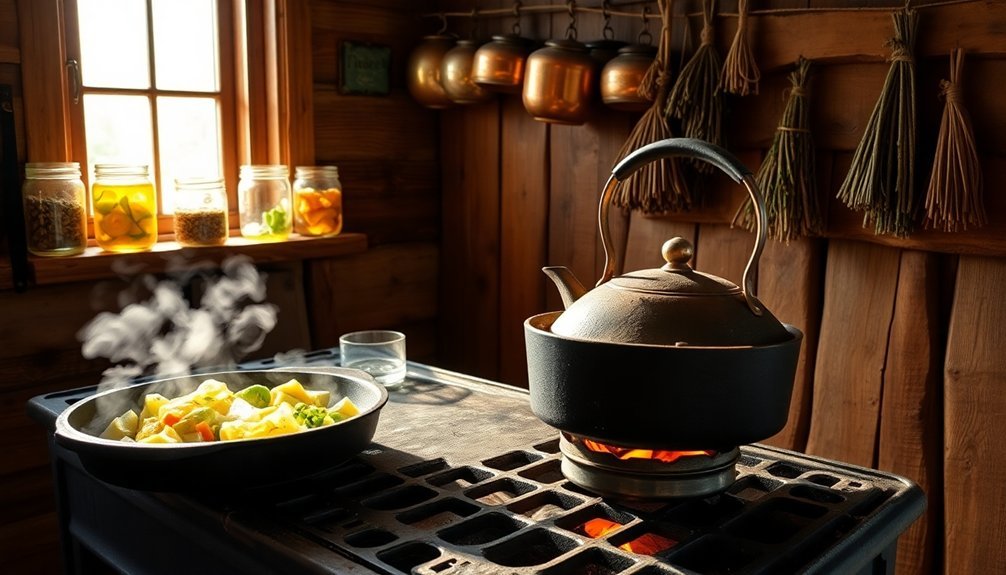



Leave a Reply